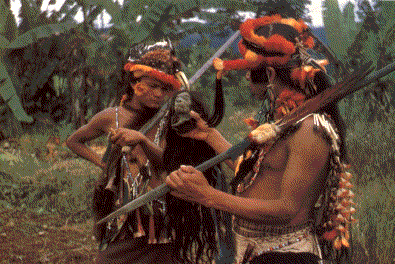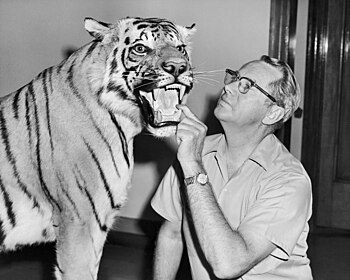Comparing the shrunken heads of the Shuar
people with the taxidermied animals of the colonial peak of the British Empire,
one can identify a number of conceptual similarities, as well as oppositions.
Superficially, the two practices seem rather distanced, one being modification
of human remains by Indigenous groups in South America, the other being
modification of animal remains by European colonizers and large-game hunters. A
number of themes arise with the practices of both that provide intriguing
insight into the ways human groups all over the globe subordinate others and
how such assertion is symbolized through material means.
Focusing
on the visual product of each practice, one sees a stark difference between the
shrunken heads and the taxidermied animals. Both the Shuar and the colonial
taxidermists would initially dismember the individual; only the head would be
used by the Shuar, however, its contents removed and the skin stuffed and treated
to preserve. Visual evidence of the eyes and lips being sewn shut would remain.
The outcome would be a warped, unrealistic figure with little resemblance to
the individual alive. Realism in depiction was not intended with this practice,
whereas it is central to taxidermy. While the animal would be disarticulated
and its contents removed as well, great pains are taken to reassemble the
individual and disguise all marks of modification. The skin is treated
and shaped over a model to create as lifelike a figure as possible; otherwise
the goal of the taxidermied animal, which is to display the dead in an ideal
manner as if still alive, would not be achieved.
The length
of possession differed between the Shuar and the European taxidermists as well.
The tsantsas were not intended to be accumulated, at least not until European
involvement, but rather created, utilized in a symbolic and ceremonial context,
and then subsequently discarded. It was in the production and instance of usage
that the tsantsas gave warriors and their communities its power. This treatment
of the tsantsas signifies the notions of a fluid power structure held by this egalitarian
group; while power can be obtained, it is still subject to change and movement throughout
the community, and simply cannot reside within one individual for the span of
their life. Taxidermied animals, on the other hand, were made to be kept and
displayed. Housed within museums, they formed entire collections of animal
specimens. The figure was a trophy of the might of both the hunter and the
imperial nation, and its eternal preservation ensured the eternality of the
power of both bodies. The goal of taxidermy, to achieve a state of ideal permanence,
required that the figures be possessed and observed; if the animals were locked
away in storage without proper upkeep, they could become tattered and disconnected
from the identities of the original hunters and taxidermists for whom they
represent, losing the original purpose of the killing.
Although
both the practices of Shuar tsantsa production and colonial taxidermy required
the killing of an living being, the function of this killing was not the same.
The tsantsas were traditionally fashioned from those who the Shuar fighters
encountered during warfare, generally adult males, but occasionally the women
and children of their enemy groups as well. Prior to the European demand for
tsantsas, the conflict between the Shuar and their rivals, usually the Achuar,
did not arise simply for the production of tsantsas. It was social and
political disputes between the groups that would initiate the killings, and the
consequential tsantsas would be manufactured as a result of victory. Not surprisingly,
once the European colonizers sought out possession of their own tsantsas as
exotic trinkets for their own collections, some Shuar individuals would kill
others to meet this demand if they did not possess tsantsas of their own or
could not steal them. Traditionally, however, this was not the intention of the
intergroup violence, and tsantsas were not acquired in this manner. Contrastingly, the colonial hunters who obtained the
individuals for taxidermy would do so specifically for the purpose of creating
the figure itself. Generally, it would not be in self-defense nor for another
pragmatic motivation, that the animal would be killed; hunters would enter wild
and exotic terrains with the goal of poaching a wild beast for their own
collections. While one could argue that the production of tsantsas was
secondary to the violent conflicts between the Shaur and the Achuar, the
production of taxidermied figures was often the primary purpose of colonial
hunting expeditions.
In terms
of the selection of individuals, there is some similarity between the two
practices. Primarily the tsantsas and the taxidermied animals would be formed
from the remains of adult individuals, although youth are also seen in both. Older
individuals are not preferred for taxidermy as they do not conform to the ideal
physicality that is the goal of the practice. As a consequence of war, adults,
who were more likely involved in the conflict, would be utilized, although (as
mentioned above) the conflict between the Shuar and their enemies would not be
primarily for the purpose of tsantsas production. The symbolic functions of
both the tsantsas and the taxidermied figures are similar as well. Both embody
the power that is required in their respective productions, visual evidence of
the assertion of one’s will over that of another; the tsantsas represent the
warrior’s superiority over his victims and the group’s might over their
opponent, and the taxidermied animals signify the hunter’s power over the
wilderness, as well as the colonist’s subordination of the colonized.
The identities of the figures
themselves are both juxtaposed, in that they are, quite apparently, the remains
of a living individual on the one hand, but reduced to an inanimate artifact on
the other. Both the tsantsas and the taxidermied animals are employed in the
construction of duel identities. The tsantsas embody the identity of the warrior
who produced it, while also aiding in the production of the community identity
and its fluid power structures. The taxidermied animals are used as trophies of
the hunters’ skill, while their production, accumulation and housing within
museums in the name of colonial exploration and the scientific pursuit of
knowledge helps shape the national identity of the Empire.
The two practices are seemingly
unrelated to one another. If one considers the activities involved and the
symbolic component of both, however, the similarities become more apparent. One
could make the argument that when the Europeans made contact with the Shuar and
increased the demand for tsantsas, they were doing so with similar motivations
as when they poached exotic animals for taxidermy. The goal of the colonizers
was to obtain symbolic materials from the exotic in order to demonstrate their
own masculinity and dominance over the colonized, such as the Shuar; an
effective way to do so would be to incorporate the powerful symbols, such as
the tsantsas, that the Indigenous populations possessed and to transform their
meaning from being representations of Shuar power, to emblems of the colonial
impulse to conquer and accumulate.






No comments:
Post a Comment